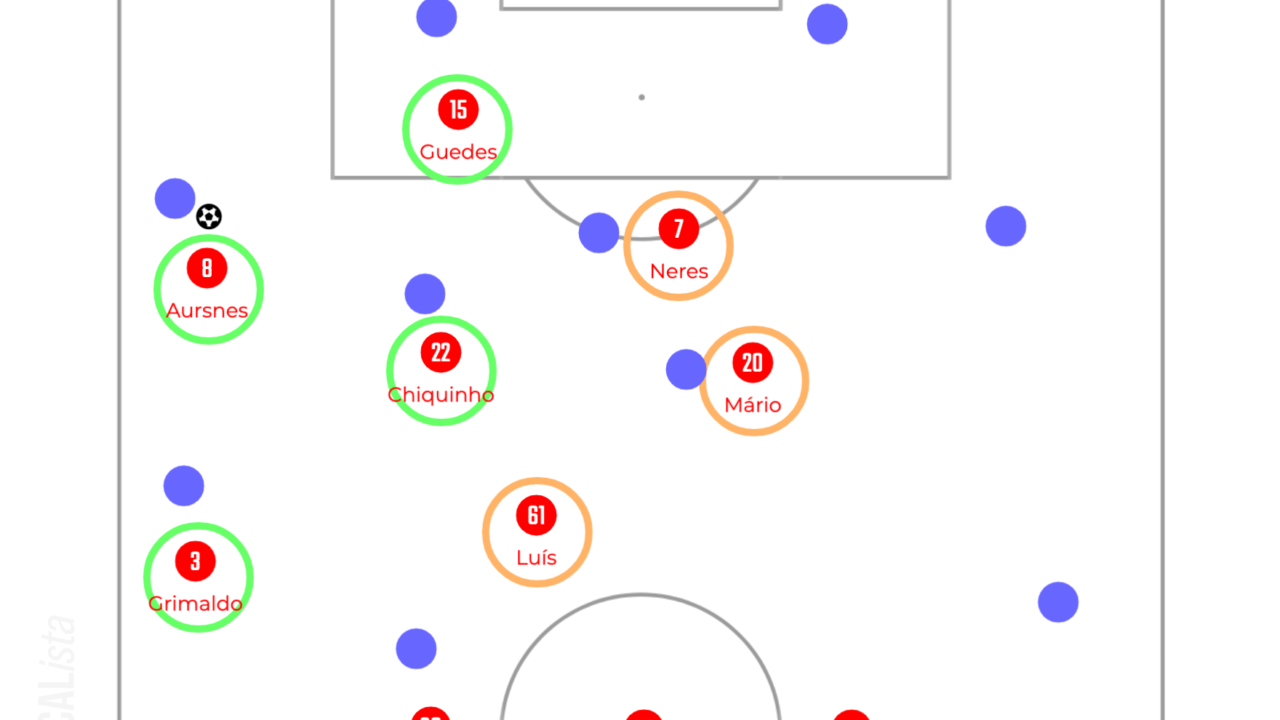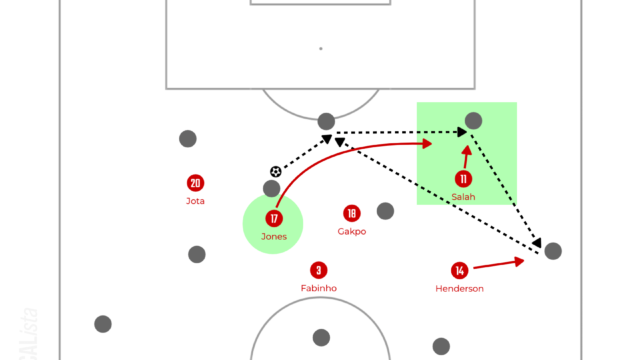SL Benfica, who are the current league leader of Primeira Liga in Portugal and qualified to the round of 16 in Champions League as the group winner with two draws against Paris Saint-Germain and two wins against Juventus, are playing fantastic football this season. The football is extremely aggressive with a classic 4-4-2 and really organised by Roger Schmidt.
After the World Cup, Enzo Fernández got attention from some big clubs and finally Chelsea bought him with the record breaking 107 million pounds. This Argentine had played an important role as a central midfielder and contributed to both pressing and final third attacking.
In this article, the tactical analysis of SL Benfica will be delivered with a discussion about the departure of Fernández. I hope you will enjoy it.
Pressing
Usually, tactics in possession will be analysed first, but as their biggest strength is the aggressive and organised pressing, so let’s begin discussing Schmidt’s idea of pressing.
Their main system is a 4-4-2, but it looks like a 4-1-3-2 when they force the opposition team to play wide and love them in. As soon as the pass to one of the opposition fullbacks is played, they shuffle across to the ball side and apply pressure on the opponents tightly.

The key things here are two important roles to surround the ball and the opponents. The first one is that as soon as the opposition team plays outside, the ball side striker, wide midfielder and central midfielder to find opposition players to mark. This tight man marking make it harder for the opposition player on the ball to find a passing lane and he is likely to play forward. Then, this is another strength of Benfica, all defenders are excellent at winning ground duels. Defenders often steps up to keep tracking opposition attackers to prevent them from turning and facing forward or ideally intercept the pass. Overall, they are so aggressive and intense in the ball side to win the ball.
The second one is the task for players away from the ball. No matter how intense they press around the ball, if the opposition team can switch the ball to the other side, it will turn into the disadvantage situation. Thus, it is extremely important for the players in the other side to keep locking the opponents in the compact area. The opposite side striker, wide midfielder and central midfielder tuck inside and cover the space behind players who press and mark the opposition players. As a result, the overall shape looks like a 4-1-3-2. Additionally, when the opposition team plays goal kicks, they sometimes position themselves in the 4-1-3-2 as one of the central midfielders steps up.

So far, the tactics of pressing in the opposition final third were discussed. They must be so aggressive with man marking around the ball because it is impossible to keep the vertically compact shape due to the offside rule. However, in the midfield, they change the way to press little bit to force the opponents to play back and create the situation which was discussed earlier.

In the midfield, they can maintain the vertically compact shape with keeping the back line high. In addition to this, they will keep each line narrow and create an overload in the ball side with leaving the opposite side completely. Their aim is closing the gap to prevent the opposition team from playing through and let them play back. Thus, both central midfielders keep checking their shoulders to screen the passing lane to the opposition players in between lines instead of jumping to press. Then, they will push the team up and try to press in the way which was analysed before.
However, in order to force the opposition centre back to play back, the wide midfielders often keep their body angle facing inside to block the passing lanes to the fullback. Consequently, if this tactic does not work, one of the central midfielders will be dragged out to jump outside. Therefore, in the midfield, the role of both wide midfielders is extremely vital for Roger Schmidt’s side.

In terms of their counterattacks, the strategy is really similar to what they do after successfully playing though, so it will be discussed in the chapter of build up.
Final Third Defending
Basically, in the final third, they try to keep the line as high as possible. Similar to the pressing in the midfield, they are trying to not only defend the goal, but also force the opposition team to play back to push the team up.

In order to control the line perfectly, the centre backs often stay in the middle, which lets them focus on mainly controlling the back line. Sometimes one of the centre backs jumps wide to apply pressure on the opposition player on the ball in the channel, but this area is mainly defended by central midfielders or wide midfielders.

Overall, the back line is more zonal defending in the final third than when they are pressing. This helps them not only defend the space in front of the goal, but also keep pushing the back line up. It is possible to say that this reflects the philosophy of Roger Schmidt to act aggressively even in the final third.
Build up
The main strength of Benfica is their intense pressing and clinical counterattacks. This is mainly the phases of out of possession and attacking transition, but they try to create a situation similar to counterattacks from in possession phase.
However, they are not like Brighton or Aston Villa who are excellent at dragging the opposition team out to create and exploit the space between lines or in behind. As Benfica’s biggest strength is pressing and counterattacks unlike them, they are willing to play over and lose the ball. This attitude towards the possession of the ball is more similar to Eddie Howe’s Newcastle United.
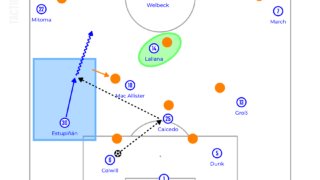
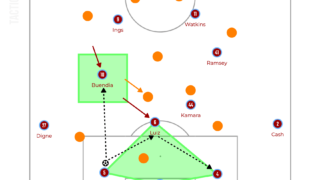
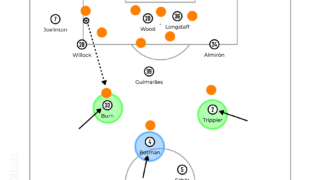
Of course, this does not mean they have no idea when playing out from the back. Their objective in build up is finding mainly wide midfielders in between lines or in behind or number 10 Rafa Silva. Then, after they can successfully turn and face forward, they begin ‘counterattacks’.

The movements here can be seen when they play actual counterattacks after winning the ball. As soon as one of midfielders can receive the ball in between lines, other attackers make a run in behind. The striker makes a diagonal run in behind to push the opposition back line back and create a diagonal passing lane and wide attackers also sprint forward to join the attack.
Overall, in possession, they are willing to lose the ball as they can play much better out of possession and trying to play forward as quick as possible. Then, they create a counterattack situation from building up.
Final Third Attacking
Benfica needs to play differently in the domestic league and Champions League. When they are playing in the Champions League, as they played against Paris Saint-Germain and Juventus this season, they are likely to play in their favourite way. However, sometimes in the domestic league, the opposition teams in the lower table try to defend deep and let Benfica possess the ball. In this kind of situation, they have to find a way to breaking the deep defensive block. Firstly, let’s take a look at the system when attacking in the final third.

As it is illustrated above, attackers positioned themselves narrow in the block, fullbacks go higher and Chiquinho often drops back to create 3-1 shape at the back. In the middle, they try to use the overloads in between the lines. After playing through, the player receiving the split pass lays it off and they try to break the opposition back line with one-touch combination.

When they use the wide areas, as similar to attacking in the middle, attackers come across the side to create an overload. One of the most repetitive patterns is one of the attackers makes a run into the channel. This can give another passing lane to an attacker in between the lines or allow the fullback on the ball to dribble inside. Especially the left fullback Álex Grimaldo is great at making a move to the space inside with dribbling or underlapping runs.

In terms of crosses, especially when they can attack quickly, both fullbacks tend to deliver low and fast crosses to the space in between the opposition back line and goalkeeper. And attackers try to run towards the goal and tap the ball in.
Overall, it is important to consider about the connection of phases of play. Their biggest strength is the intensity out of possession and it is same when they lose the ball, defensive transition. One of the reasons of attacking with overloads around the ball instead of switching the ball many times and using the pitch big is winning the ball back soon after losing it. Thus, they like to play in small area with many players to make it easier when the lose the ball.
The Departure of Enzo Fernández
Enzo Fernández is a great player and extremely vital for Benfica. He can lead the pressing with moving other players by his instruction. His awareness is excellent and always understands the task. Not only his tactical understanding, but he is also physically good enough to win the ball by his pressing. Additionally, in possession, he moved a lot to receive the ball behind the opposition strikers and could carry the ball forward. In the final third, he can deliver accurate balls and also attack the box. Yes, he is a genius box to box player which is essential in a 4-4-2.
However, Chiquinho, who has started the game as the replacement of Fernández after he left the club, is also a good player. He is good enough to help the possession at the back. The difference is he does not join the attack around the box as often as Fernández did.
Even though there are differences, they can play very well as a team because the quality of the team is excellent. The high-level tactical understanding of most of all players can help the team work as good as usual even though some players were changed. The fact that they can still play fantastic football without the 107 million pounds player shows it. It will be proved in their Champions League games. Thanks for reading.
